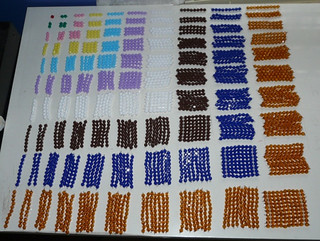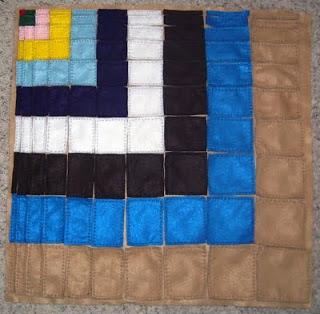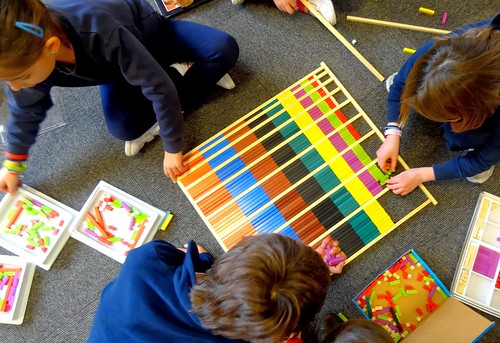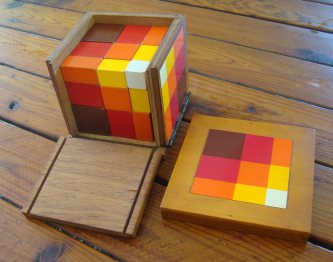Week 4 Task 3: Decanomial squares
Today your mission is…
Build decanomial squares, using the array model of multiplication. Array is the best model to explore algebraic properties of multiplication such as commutativity, and algebraic identities such as (a+b)^2=a^2+2ab+b^2
Ready, Set, Go
A decanomial square is a multiplication table made out of arrays. You can use different materials to build your squares.

Graph paper, by Somewhat in the Air. You can design and print graph paper online or make it by hand. Use larger cells with younger kids.

Homemade Montessori beads, by Our Homeschool Journey. This takes a long time to make by hand!

Felt, by Walk Beside Me. Note that unmarked pieces have more perplexity, forming visual, geometric puzzles. Bead pieces or graph paper pieces are easier to sort and push toward number patterns and algebra. You can make the same design out of construction paper.

Cuisenaire rods, by Simon Gregg. This combines visual aspects (rods don’t have unit marks) with counting (the number of rods).
Your forum response
- What multiplication ideas do you see in this topic? What bridges connect this to your everyday life, sciences, and arts?
- Did you use this with kids or students? How did it go? What did they say and do? What questions did they ask?
How to help your child to get started
Reach for your child’s favorite medium whether it’s clay, paper, beads or anything else. Start the pattern and ask the child for help. Play “what goes next” game. Make mistakes in the pattern to give your child an opportunity to correct you.
If you are working with younger children, keep the squares small, only two (binomial) or three (trinomial) numbers. The squares can grow with your child.


Photo of trinomial square and cube by Simanaitis Says
Frequently Asked Question
When it comes to “continue the pattern” activities, my child is quick to figure out the pattern, but starts making mistakes after just a couple of steps. Why? How can I gently correct my child’s mistakes? And should I do it in the first place?
For the reasons why kids break patterns, revisit our activity Your Child, the Divergent Thinking Genius. Consciously or not, children play around, change patterns, notice and immediately implement new possibilities. An adult is likely to hold a neat alternative for later, while carrying on the current pattern. Many kids don’t see any point in carrying a pattern beyond the moment they understood it.
Once a kid gets a bright new idea, it’s very hard to carry on the old pattern, even if the kid wishes to do so (which is rare). Children don’t have enough short-term memory or attention to hold two patterns in mind. So for children, the healthy way is to implement their bright ideas right away, lest they forget!
Don’t think of pattern-breaking as a mistake, because most often it isn’t. It’s play or creativity. Don’t: distract the child from brainstorming about patterns! Let the child play. Do:
- Observe quietly for a while, to understand (or to make up) a pattern behind your child’s new idea.
- Copy that new pattern yourself, making 4-5 steps of it. When your child pauses from play, ask if you got the idea right.
- Sometimes children keep changing the rules again and again. Make all the patterns you notice.
- Also make the old, original pattern. Admire, compare, and photograph all the patterns you made together.
Think of yourself as a catcher of the wild patterns your child generates. Gotta catch them all!
Words
Decanomial, commutativity, square, binomial, trinomial
People who like this
Your answer

Answer by Eogruen · May 21, 2014 at 08:57 PM

we did this with some wooden math rods. Was a good reinforcement of yesterday's activity. We enjoyed seeing how the table created a diagonal line of squares-numbers times themselves! The best part though is that when playing with the rods afterward, my seven year old discovered division all on her own when she showed me that you couldn't divide ten by three... Lots of play and discussion followed.
This is wonderful! Where did you get these "rods"? We call them Segs, short for line segments, since they are one dimensional. :-)
I have always had to use centimeter cubes to build our Segs, Squares, and Cubes, but and would love to have a set of pre-made.

@rebeccalynne68, I have no idea where the rods came from as they were passed on to me by my mother who acquired them in the 80s. You could look for cuisinare rods, those are still around...
Answer by rebeccalynne68 · May 22, 2014 at 01:22 AM
I have used centimeter cubes with kids to show the base pattern down the vertical edge reading horizontally. These visual patterns show why the commutative property has some slight variation: three groups of four vs. four groups of three. Yes, the answers in decanomial numbers (base ten) are the same, 12, but are the numbers represented the same? No. Three groups of four are just that, three Segs (short for "line segment") of four, whereas four groups of three form a Square that is 3x3 and one Seg of 3. These new shapes scream for a little algebra conversation about Cubes, Squares, and Segs...
 Looks like a conversation about subQuan to me. ;-)
Looks like a conversation about subQuan to me. ;-)
Answer by Rodi.Steinig · May 16, 2014 at 12:41 PM
One idea I had that I didn't get to implement is to make decanomial squares with Perler beads (those plastic beads you can iron into patterns). I'd love to know whether you can get a base square large enough to do this. Do any of you know?
@Rodi.Steinig - this super-size pegboard should work: http://www.herrschners.com/product/SuperSized+Clear+Peg+Board.aspx
It's a good math problem to figure out - will the board fit my project?
Answer by Rodi.Steinig · May 08, 2014 at 06:52 PM
This was such a powerful activity. It posed a lot of challenge and frustration at first (but not too much, as the kids felt confident from having done the prior week 2 tasks), and then turned into pattern-recognition and pattern seeking as they went on. Due to time, no one was able to finish theirs in the group, but each took them home to finish. It was a great opportunity for discover as each girl asked frequently, "is this right?" and each time I answered with the instruction "count them and see." They were able to diagnose their own success.

Answer by Goya55 · May 06, 2014 at 03:11 PM
I cant post our photo's here as everything must be shrunk and I do not know how to do this with an iPad. My son just did this Montessori work, it takes along time and he likes seeing the whole thing finished.
@Goya55 - you can email your big pictures to moby@moebiusnoodles.com - I'd love to see them, and I will post them here.
Answer by Elizabeth02 · May 04, 2014 at 03:22 PM

Of course we used Legos for this and my son mostly just counted up one each time and followed the pattern. We had a good time with it though. I helped him through number six and then I thought we were done, but I found him working more on it later (no complaints here!)
Answer by mrs123 · May 02, 2014 at 07:52 PM

We did this on graph paper. My 1st grade daughter started off well but grew tired of it and needed my help by the time we got to the bigger numbers. There were a LOT of dots to make! Still it was a beautiful end product. It reminded us of pointillism in impressionistic paintings.
@mrs123 - how long it takes you (or mom) to make an array is a great way to grow your number sense and intuition about multiplication! What a beautiful art project. Are you going to keep it up as a poster?
Answer by AGray · May 02, 2014 at 02:41 AM
My son is going to try this on Minecraft. If I can remember where my montessori beads are we are doing a live version. Or maybe we'll make a felt one, my kids loved that picture...
Answer by LeistCatalano · May 01, 2014 at 08:30 PM
I started to do this as an example with our legos. We have 10K+ legos, but it turns out they are all odd shaped. It took some time to find even a half set here. My kindergarten age son was intrigued...

Answer by babyhclimber · Apr 30, 2014 at 04:36 PM
http://ekladata.com/ZTNPZRX5qwZQo4IYEc0mKWrQAyU.pd... I found this set of directions/explanations. This motivated my son to build his in minecraft. The pink tower and broad stairs were also neat representations.
http://static.squarespace.com/static/519e5c43e4b03... is neat for those with the right materials. We might try to print this off & use legos. Loved the later pages in terms of comparing measurement & more than one way to get to the big square
Answer by sherylmorris · Apr 27, 2014 at 11:17 PM
Want more?
Find below instruction given to Montessori teachers in training: Square or the Decanomial, Numeric Decanomial, and Algebraic Decanomial.
Follow this Question
Related Questions
Week 4 Task 1: Multiplication models bingo 9 Answers
Week 4 Task 2: Real times tables 6 Answers
Week 4 Task 4: Coloring the table 4 Answers
Week 4 Task 5: Healthy memorizing 1 Answer

